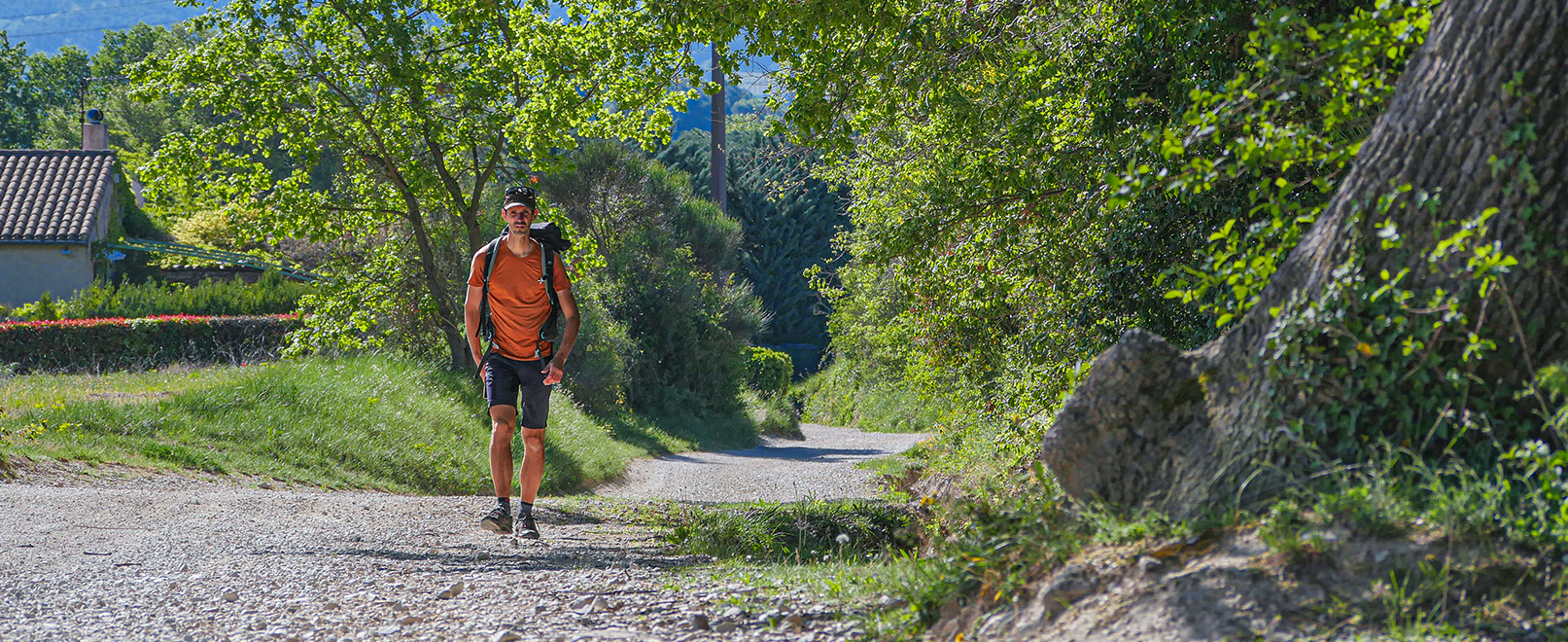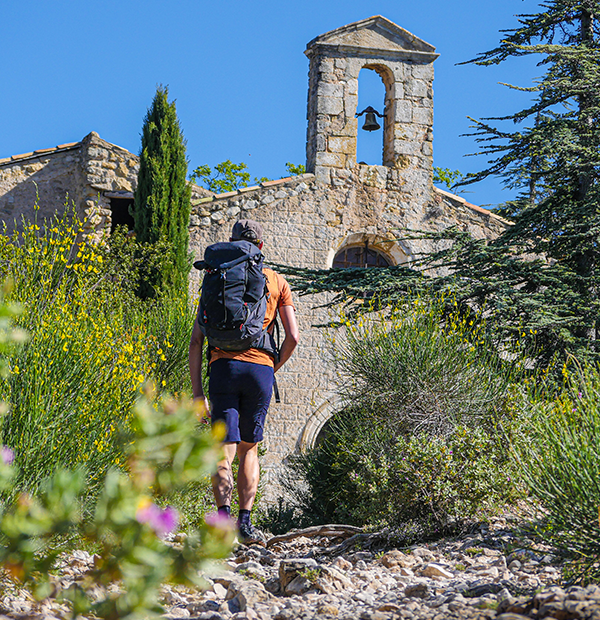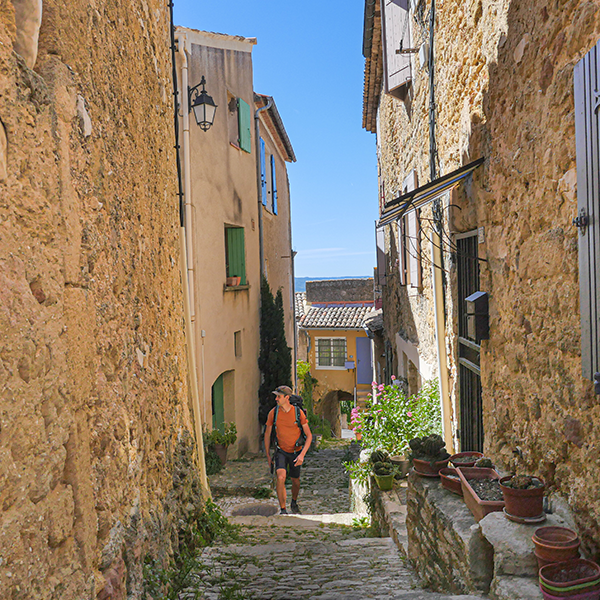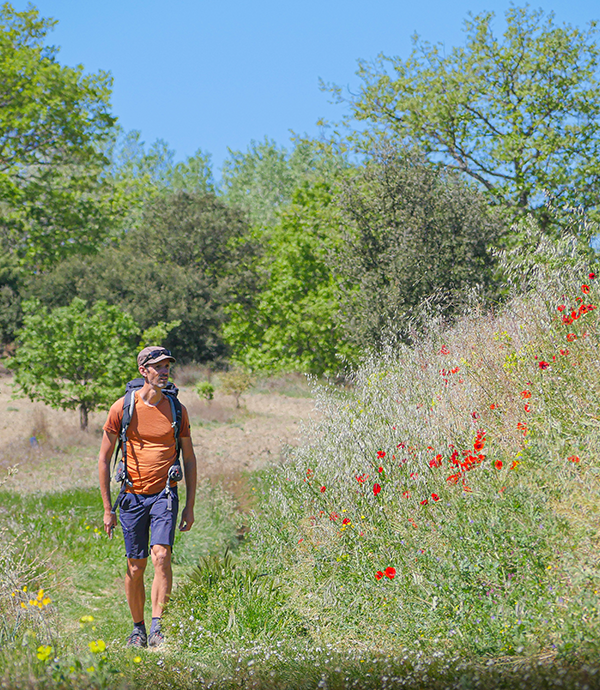
Hiking in Cucuron, from past to present
Cucuron and the Luberon: the rhyme recalls the close links forged between the village and the massif over many centuries, as evidenced by the pieces of history scattered along the way. In the shadow of the summit of Mourre Nègre, turned towards a sea of vineyards and olive groves, Cucuron glows with a modest elegance that embodies the provençal spirit. A land of light and traditions, cultivated and inhabited, it invites you to explore it along an easy loop, particularly in the first stirrings of spring when the vineyards are still in their infancy, along byways that smell of Provence.
Duration:
1 hour
Type:
Hiking
1 – From grapevines to the hermitage
From the Cucuron car park to Chapelle de l’Ermitage
We exit Cucuron via Chemin de l’Hermitage. It’s a beautiful walkway, with soft hills serving as a border between the disorder of the undergrowth and the precision of the crops on the other side. You’ll be able to hear the song of the common nightingale and admire the slopes covered with Italian catchflies and tufted grape hyacinths. Higher up, a narrower trail climbs, through brooms and shrubby scorpion-vetch, up to Chapelle de l’Ermitage. It’s a short, manageable climb up to this peaceful place of communion, set amongst beautifully landscaped surroundings. It boasts a gleaming exterior, at the top of which is a small bell. Enjoy your first break here, taking in its unique charm, the sweet scent of lilacs and its gentle, holy aura, as well as the view which extends as far as Pays d’Aix and the ramparts of Sainte-Victoire which lie there.

Did you know?
Cucuron, like Vaugines, has been the backdrop for several major films. Amongst them are Manon des Sources (1986) directed by Claude Berri, le Hussard sur le Toit (1985) directed by Jean-Paul Rappeneau, and Une Grande Année (2004), directed by Ridley Scott, with Russell Crowe and Marion Cotillard.

2 – Vaugines and its surroundings


A fond favourite
The aptly-named Place de la Fontaine invites you to enjoy a well-earned break in the café with which it shares its name. The spirit of the village is captured here in this lively spot, where the locals meet, right next to the town hall.
From Chapelle de l’Ermitage to Vaugines
Vineyards, fruit trees and beautiful open spaces, watched over by the silhouette of Mourre Nègre, stretch as far as Vaugines. The oratory of Notre-Dame-de-Vaugines, forerunner of the church of Saint-Barthélémy, stands at the end of a path hidden beneath oak trees. Bosco’s shadow looms over Vaugines as you wander through its narrow streets, following wherever your curiosity leads you. Much like Cucuron, Vaugines possesses a simple charm and an authenticity that hits the spot. The village is an emblem of the Provence of the last century; wild yet charming, it has been shaped by the history of man as it has by the magic of nature. It’s like a microcosm of provençal life built on ancient heritage, with a hand-drawn map of the town that invites you to explore every last one of the sights marked on it.
3 – Heading back to Cucuron
From Vaugines to Cucuron
We leave Vaugines via Chemin de Magnan, a road lined with vine stocks on either side. The route is as secluded as possible, alternating between charming paths and country roads which run through this densely populated area. Wedged between old dry stone walls, to which a few stubborn tufts of thyme or rosemary cling, or headed down a sunken path which plunges between two embankments beneath the protective cover of oak trees, you’ll feel like you’re in a world of your own. The oak plantations shelter precious truffle beds, another local jewel after wine, olive oil and lavender. Shortly you’ll have reached Cucuron, where you can climb up the secret passages of its streets to its dungeon – the final chapter of a beautiful journey that we have completed in just a few hours.

Did you know?
Cucuron was badly hit by the plague between 1720 and 1721. Almost two thirds of the population were affected, making it the village which paid the highest price for the epidemic. An information panel pays tribute to the deceased on the hill of Donjon Saint-Michel.

More of a walk than a hike, this easy little loop dives into the old and recent history of this little corner of Provence in the shadow of the Luberon. I came across some stunning villages, linked by sections of path that ooze rustic charm. It’s a walk to take slowly, with a smile on your face.
The hike in practice

Download :
– GPX trail
– Technical details of the hike (fr)

Details :
– Distance: 6 km
– Elevation gain: 128 m
– Duration: 1h
– Difficulty : easy

Get there by car : 13 km north-west of Pertuis, via Ansouis and the D56

